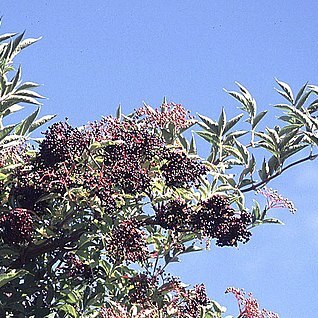Shrub or tree, to 20 m tall, stems terete, glabrous, usually drying finely striate; the pith white or slightly buff-colored. Leaves somewhat fleshy, mostly 7-11-foliolate; leaflets ovate, oblong or lanceolate, apically acuminate, mostly rounded basally, sometimes obtuse, 8-20 cm long, the margins evenly fine-serrate almost to the base, above glabrous except for minute simple hairs on the midvein, beneath This content downloaded from 192.104.39.2 on Thu, 9 May 2013 15:30:06 PMAll use subject to JSTOR Terms and Conditions1973] D'ARCY-FLORA OF PANAMA (Family 180. Caprifoliaceae) 163 finely pubescent with short erect often curved hairs, especially on the veins, the veins mostly 7-10 on each side of the midvein; petiolules short, to 15 mm long, glabrate sometimes with stipule-like processes at the base, petiole glabrous, some-what clasping at the base. Inflorescences large and showy, 3-5-times compound, glabrate cymes to 40 *cm in diameter, situated above the leaves on elongate peduncles, the first division an umbel of 5 unequal branches often subtended by inconspicuous glandular bracts; pedicels to 8 mm long or absent, minute bracteoles mostly present, the nodes of the inflorescence minutely pubescent with glandular or eglandular hairs, the glands mostly drying dark reddish. Flowers white, calyx ca. 1 mm long, the tube companulate, glabrous, often glandular, lobed to ca. 1/3 of the way down, the lobes glabrous, obtuse, persistent in fruit; corolla campanu-late-rotate, ca. 2 mm long (3-5 mm in diameter), deeply-lobed, the lobes rotund, quincuncial in bud; stamens exserted, equal; ovary 5-loculed, the style (superior portion of the ovary) glabrous, sometimes expanding to 1 mm long in fruit, the stigmas 5, connate in a ring, nearly equal. Fruit a juicy globose berry 7-9 mm in diameter, smooth, shiny, without trace of a bloom or furrows when fresh, when dry turbinoid, 2 mm in diameter and 3-4 mm high, recessed beneath with 4-5 prominent longitudinal ridges; seeds 5.
More
A tree. It grows 8-12 m tall. The trunk is irregular shaped. The leaves are compound with 7-9 leaflets. These have teeth along the edge and are hairy underneath. The flowers are white and in groups 18-22 cm long. They have a scent. The fruit are black berries 1.2 cm across. They have 3-5 seeds.


